Pizza Dough
This post may contain affiliate links. Read my full disclosure policy.
Elevate your homemade pizzas with this simple and delicious pizza dough, made with just five ingredients.
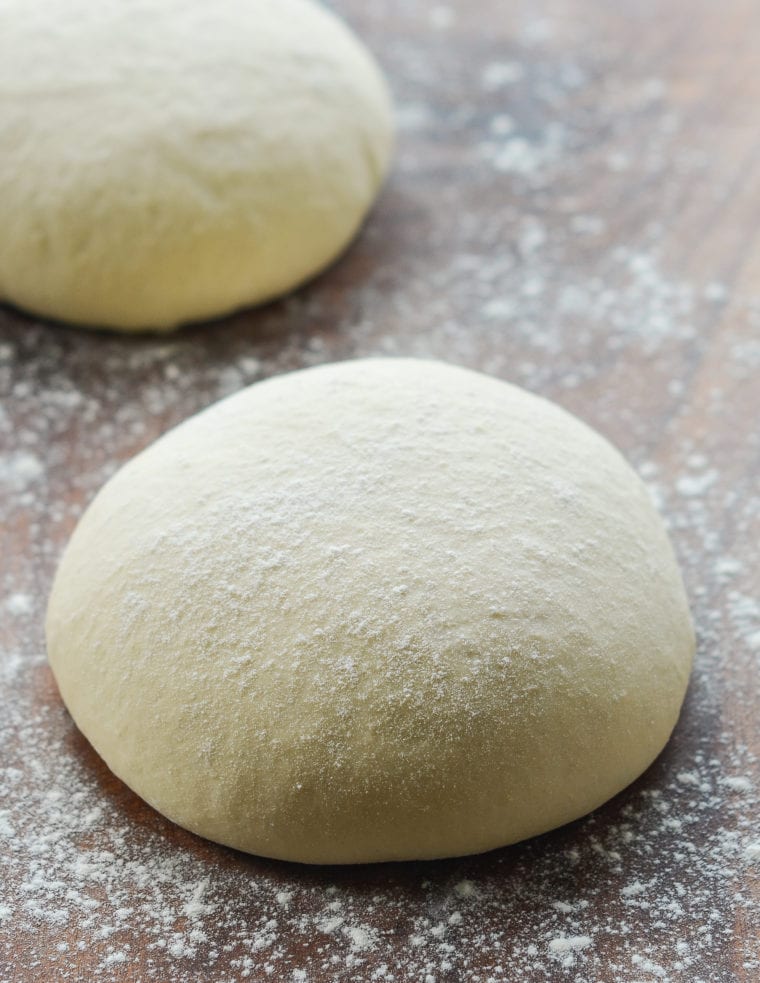
If you want to ensure a perfect crust for your homemade pizza, stromboli, or calzones, making your own pizza dough is the way to go. This simple process requires five basic ingredients — flour, salt, yeast, oil, and water — and takes only ten minutes to mix and knead. Just be sure to allow at least 90 minutes for the pizza dough to rise in a warm, draft-free spot in your kitchen before using it. This recipe makes 2 pounds of dough, which is enough for two large pizzas, four individual ones, two stromboli, or four calzones. You can make the dough up to two days in advance, and it freezes beautifully, too.
What you’ll need to make pizza dough
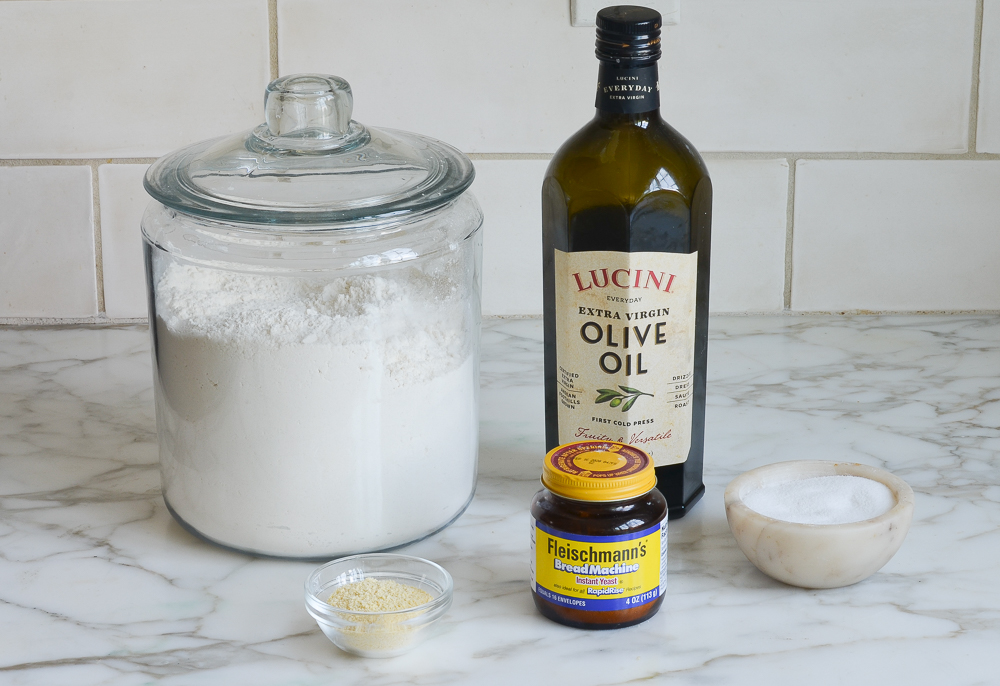
- Olive oil adds richness to the dough and helps it crisp up in the oven.
- A healthy dose of salt is added for flavor.
- Cornmeal is used to dust the baking sheet and keep the dough from sticking as it bakes; it also gives the crust a bit of extra crispiness and flavor.
- Yeast makes the dough rise. I use instant yeast, which may also be referred to as rapid-rise, quick-rise, or bread machine yeast (this is confusing, but they are all the same thing). Active dry yeast, often referred to as regular yeast, may also be used, but it will lengthen the rising time by about 50%.
Step-By-Step Instructions
Mix the Dough
To begin, combine the flour, yeast, and salt in the bowl of a stand mixer.
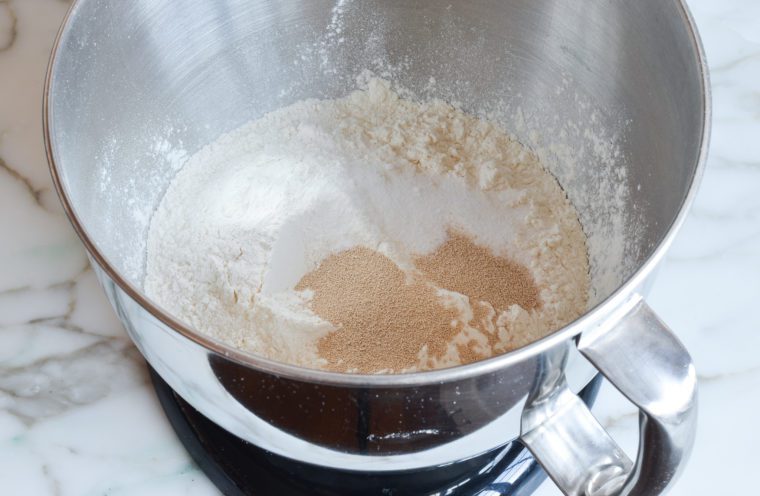
Stir with a spoon to combine, and then add the oil and warm water.
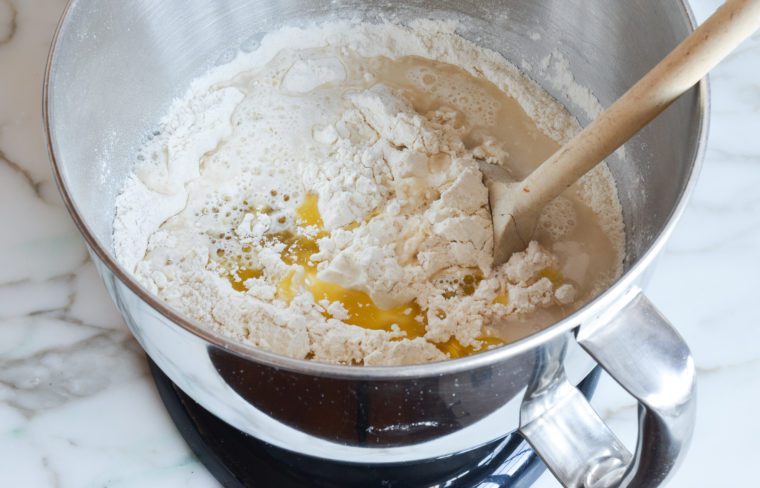
Stir until the dough comes together into a shaggy mass.
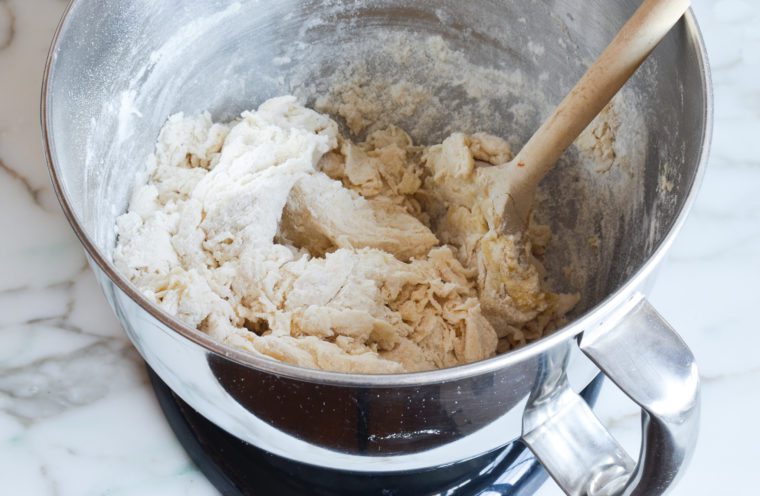
Knead the Dough
Fit the mixer with the dough hook and knead on medium-low speed until the dough is smooth and elastic, 5 to 7 minutes. (Alternatively, you can knead the dough by hand.)
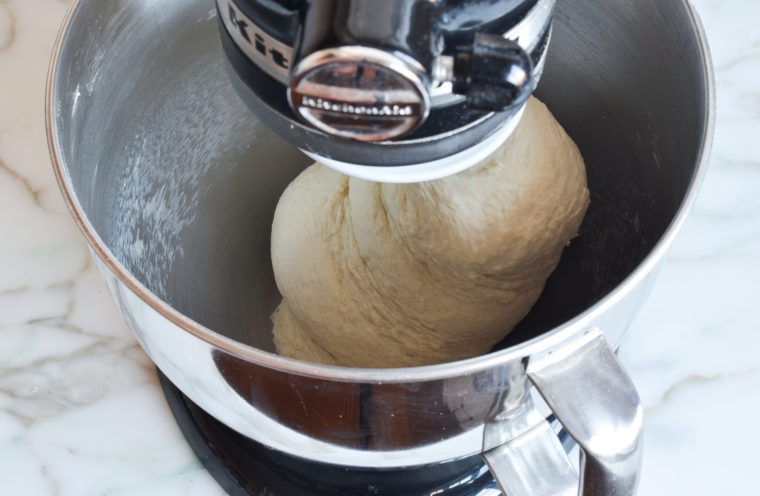 Let the Dough Rise
Let the Dough Rise
Transfer the dough to a lightly oiled large bowl.
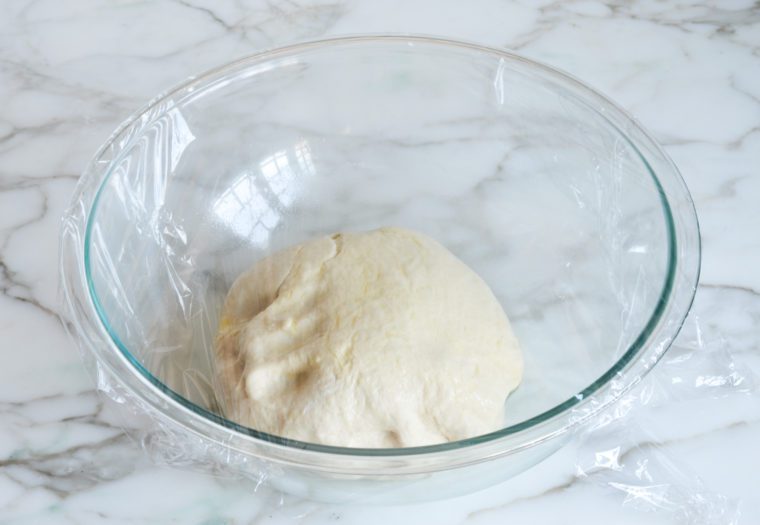
Cover the bowl with plastic wrap or a damp kitchen towel, and let the dough rise in a warm place until it has doubled in size, 1 to 2 hours.
There are a number of options that will work as places to let your dough rise: a sunny spot in your house, next to a heating vent (during colder months), or even on top of a kitchen appliance that generates a bit of heat as it runs (like your fridge). If you’re lucky enough to have a proof setting in your oven, use that. If not, but you’d like to use your oven, switch on the oven’s internal light; it will generate enough warmth to provide a good environment for the dough to rise.
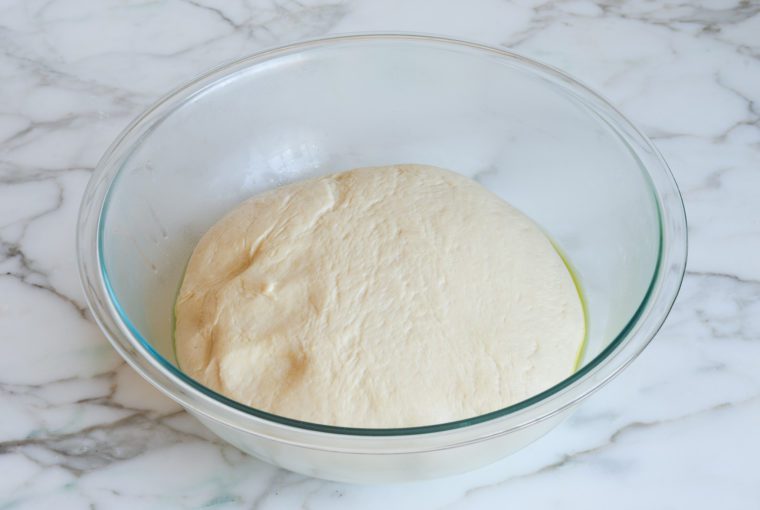
After the dough has risen, punch it down.
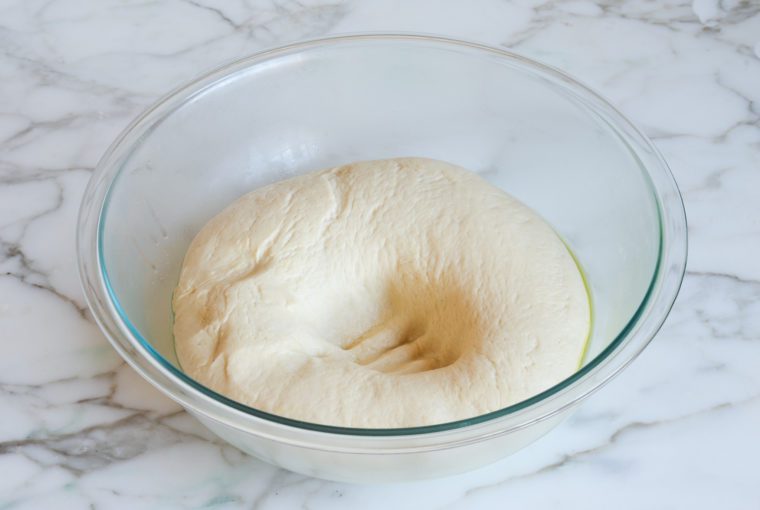
Place the dough on a lightly floured surface. Cut the dough in half and roll each piece into a ball. If you’re not using the pizza dough right away, lightly coat the dough ball(s) with olive oil. Place into freezer bag(s) and seal shut, squeezing out all the air. Refrigerate for up to 2 days. When ready to use, let the dough sit out on the countertop for 30 minutes to warm up before stretching.
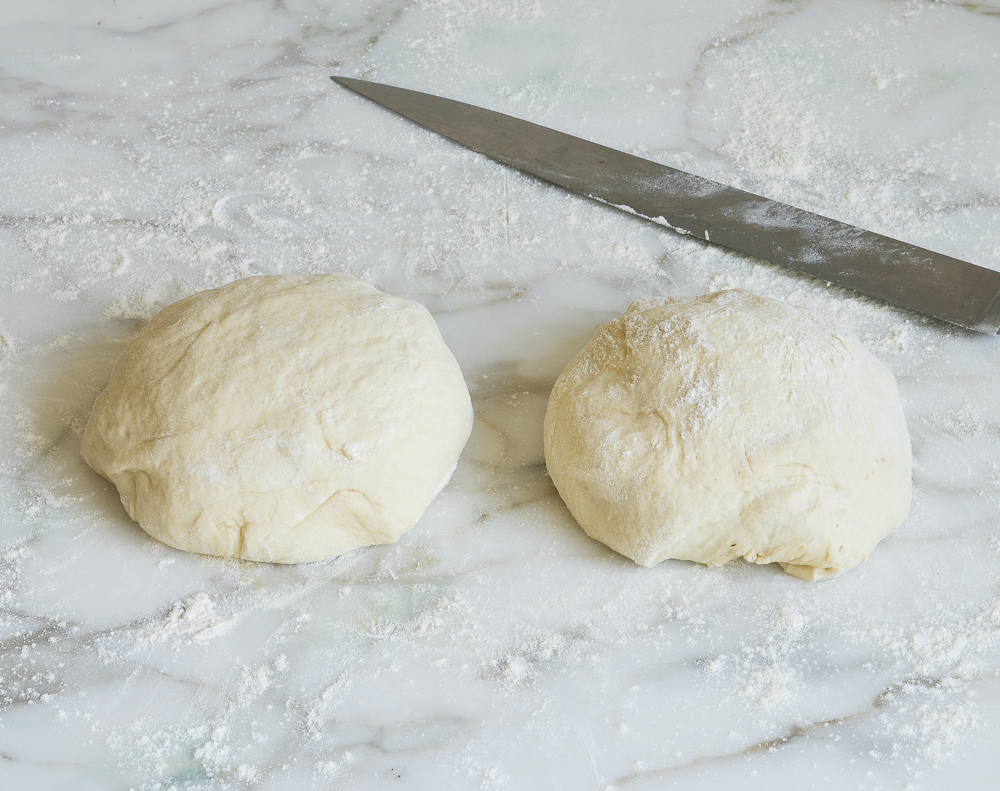
Cover the dough with a damp kitchen towel and let it rest for 15 to 20 minutes.
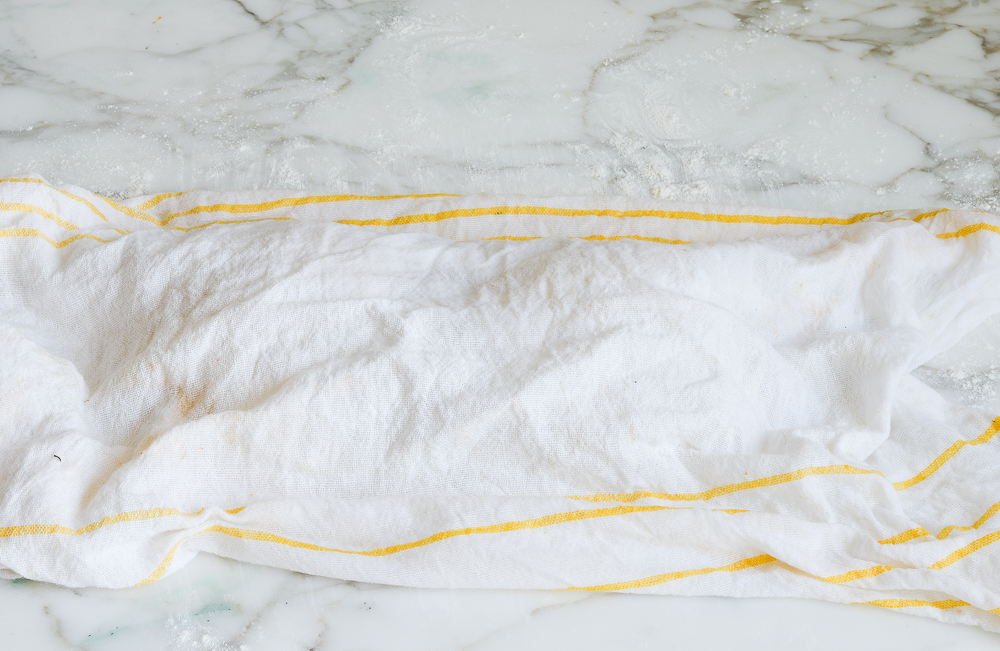
As you can see, it will rise a bit.
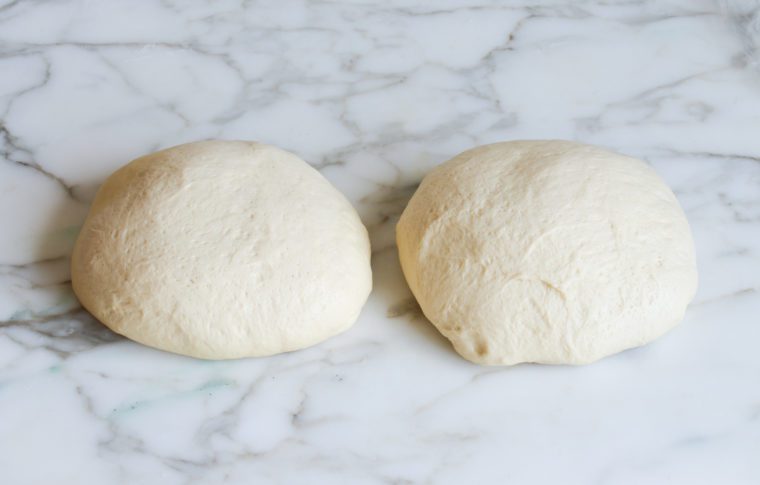
Shape the Dough
When it comes time to shape the pizza dough for baking, you can stretch it into any shape, size, or thickness you like (just keep in mind that a thicker crust will take longer to bake). Simply press and stretch the dough using your hands, dusting with more flour if necessary.
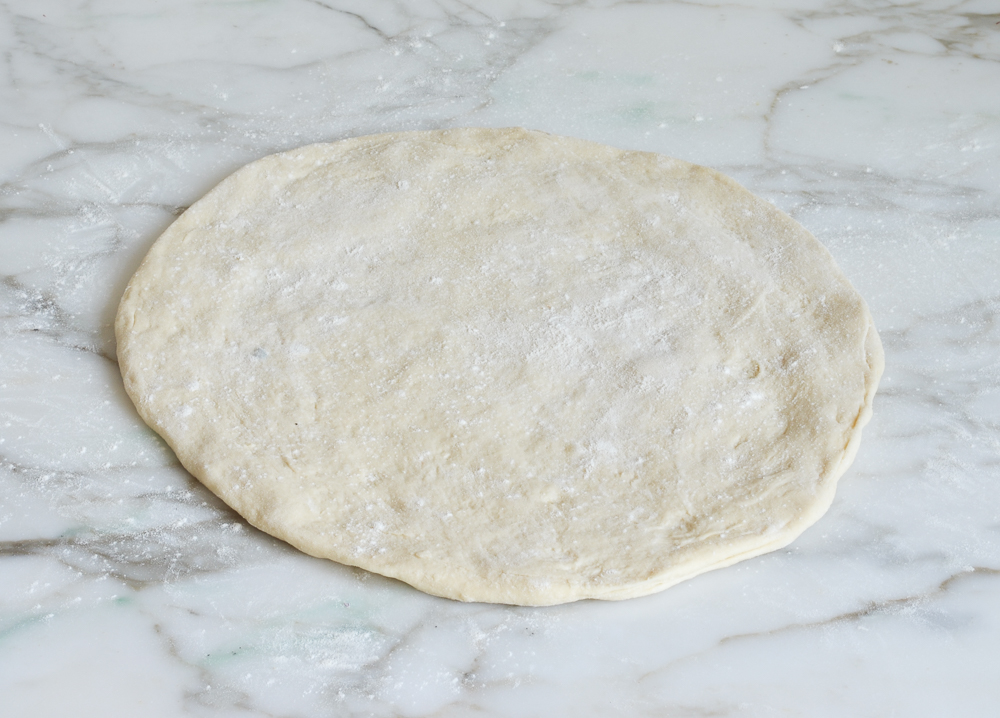
General Baking Instructions
Every pizza recipe is a little different, but as a general guideline:
- Preheat the oven to 500°F and set an oven rack in the bottom position. Dust a 13×18-inch baking sheet lightly with cornmeal.
- Place the stretched dough on the baking sheet, and gently stretch it out again so that it maintains its shape.
- Spread your sauce over the dough, leaving a 1/2-inch border around the edges. Slide the baking sheet into the oven and bake for 5 to 7 minutes, until the crust is partially cooked. Remove from the oven and scatter the cheese and toppings over the sauce. Slide the pan back into the oven and cook until the crust is golden brown and the cheese is melted and bubbling, 4 to 6 minutes more.
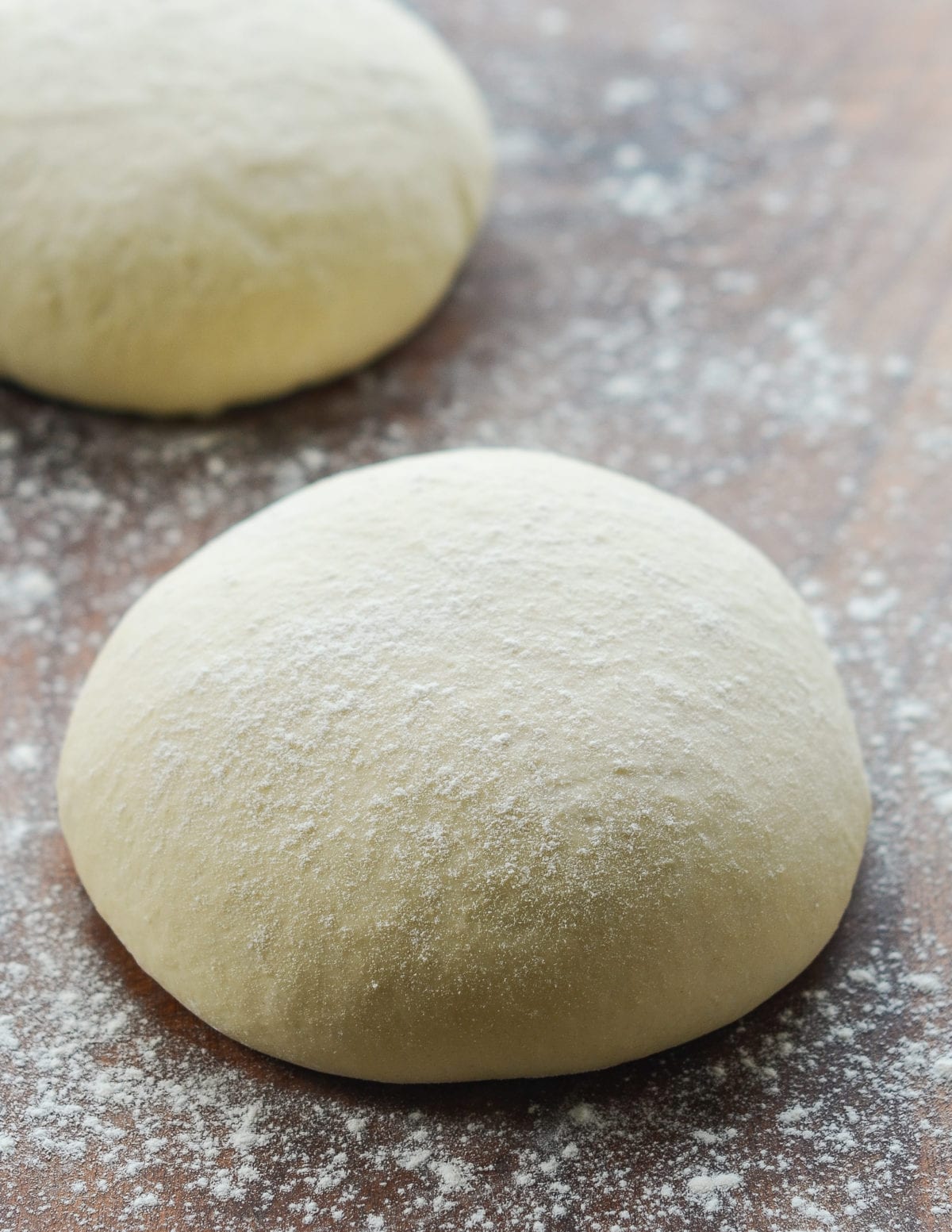
You May Also Like
- Rosemary Focaccia
- Calzones
- Margherita Pizza
- Pesto Pizza with Fresh Tomatoes & Mozzarella
- Challah
- Soft Pretzels
- Stromboli
- Pierogi
Frequently Asked Questions
Yes, if you’re not using the pizza dough right away, after the initial rise, lightly coat the dough ball(s) with olive oil. Place into freezer bag(s) and seal shut, squeezing out all the air. Refrigerate for up to 2 days. When ready to use, let the dough sit out on the countertop for 30 minutes to warm up before stretching. The dough can also be frozen for up to 3 months. When ready to use, defrost in the refrigerator overnight (or for at least 12 hours), and then let it warm up on the countertop for about 30 minutes before stretching and proceeding with your pizza recipe.
Yes but the dough will take longer to rise. To give active dry yeast a boost, you can dissolve it in the warm water and let it sit until frothy, about 10 minutes. Following that, add it to the mixing bowl with the flour, oil, and salt and proceed with the recipe.
Video Tutorial
Pizza Dough
Elevate your homemade pizzas with this simple and delicious pizza dough, made with just five ingredients.
Ingredients
- 4 cups all-purpose flour, spooned into measuring cup and leveled-off, plus more for dusting
- 1 tablespoon instant/quick-rise yeast
- 2¼ teaspoons salt
- ¼ cup extra-virgin olive oil
- 1¼ cups plus 2 tablespoons warm water (see note)
- Cornmeal, for dusting the pan before baking
Instructions
- Combine the flour, yeast, and salt in the bowl of a stand mixer. Stir with a spoon to combine. Add the oil and water and stir until the dough comes together into a shaggy mass. Fit the stand mixer with the dough hook and knead on medium-low speed until the dough is smooth and elastic, 5 to 7 minutes. (Alternatively, you can knead the dough by hand.) The dough should be slightly tacky and cling just to the bottom of the bowl; if it seems too dry during the kneading process, add 1 tablespoon of water. If it seems too sticky, add 1 tablespoon of flour.
- Dust your hands with flour, then gather the dough into a ball and transfer it to a lightly oiled large bowl. Cover the bowl with plastic wrap or a damp kitchen towel and let the dough rise in a warm place until it has doubled in size, 1 to 2 hours.
- When the dough has risen, punch it down and place on a lightly floured surface. Cut the dough in half and roll each piece into a ball.
- If you’re not using the dough right away, lightly coat the dough balls with olive oil. Place into freezer bags and seal shut, squeezing out all the air. Refrigerate for up to 2 days. When ready to use, let the dough sit out on the countertop for 30 minutes to warm up before stretching. The dough can also be frozen for up to 3 months. When ready to use, defrost in the refrigerator overnight (or for at least 12 hours), and then let it warm up on the countertop for about 30 minutes before stretching and proceeding with your pizza recipe.
- If you're planning to use the dough right away, cover the dough balls with a damp kitchen towel and let rest for 15 to 20 minutes (the dough will rise a bit). Using your hands, stretch the dough to the desired shape. Proceed with your pizza recipe, or follow the general baking instructions below.
- General Baking Instructions: Preheat the oven to 500°F and set an oven rack in the bottom position. Dust a 13x18-inch baking sheet lightly with cornmeal. Place the stretched dough on the baking sheet, and gently stretch it out again so that it maintains its shape. Spread your sauce over the dough, leaving a ½-inch border around the edges. Slide the baking sheet into the oven and bake for 5 to 7 minutes, until the crust is partially cooked. Remove from the oven and scatter the cheese and toppings over the sauce. Slide the pan back into the oven and cook until the crust is golden brown and the cheese is melted and bubbling, 4 to 6 minutes more. Remove the pizza from the oven and transfer to a cutting board. Slice and serve.
- Note: Active dry yeast may be used instead of instant yeast, however the dough will take longer to rise. To give active dry yeast a boost, you can dissolve it in the warm water and let it sit until frothy, about 10 minutes. Following that, add it to the mixing bowl with the flour, oil, and salt and proceed with the recipe.
- Note: The water should be warm to the touch — not hot — as anything over 130°F will kill the yeast and keep the dough from rising. It’s not necessary to measure the temperature, but you’re aiming for around 105°F.

I apologize if someone already asked this, but could I use whole wheat flour instead of white? If so, would anything need to be adjusted?
Hi Jess, I’d suggest starting by using half whole wheat and half all-purpose to make sure you like the texture. If you do like it, the next time you make this, you can up the ratio of whole wheat to white a bit more. Also, you may want to consider white whole wheat as it’s lighter and milder tasting than regular whole wheat flour (yet just as nutritious). I’d love to hear how it turns out!
I found the crust to be too salty for my liking, will try it again and reduce the amount of salt to about 3/4 tsp.
Tasty pizza thanks to you! Easy quick crust and I will use this again.
I’m having difficulty with the conversion chart from volume to weight. The dough recipe calls for 4 C of AP flour (which weighs 120 gm/cup.) In my math that equals 480 gms not the 520 your conversion calls for. Can you comment?
Hi Pat, Are you looking at my conversion chart? If so, I’m a bit confused as I indicate 1 cup of flour weighs 130 grams. If I’m misunderstanding, please LMK. Thanks!
This is my “go-to” pizza dough recipe. It’s as perfect as it gets. My only comment are the directions. I use yeast a lot so I have some comfort level with it but when my son in law tried to make it he had to throw it away 3 times! I talked him through it the next time he went to make it and told him to first get the water and yeast and salt established and then slowly add the flour mixture to the water. (Instead of adding the water/yeast to the flour mixture). This is the way I do it and it turns out perfect every time!!!
Hi Jenn – I’m a newcomer to your recipes – have made several and have not been disappointed with any – from the Chocolate Banana Loaf to the Baked Corned Beef & Cabbage! I’ve always been a bread baker (48 years) but for some reason have always purchased raw dough for making pizza – well – I made yours last night for the first time and I will forever more be making it when I want to make pizza! I made the recipe exactly as written – even using my dough hook for the first time ( I like kneading by hand). I didn’t need to add extra water or flour – the dough was perfect. It ‘rolled’ out to fit the pan without springing back over much and the end product – post cooking – was delicious – light, crispy and tasty. I baked it my way, made the pizza complete and baked it @ 450 for 28 mins. on a rack one down from center. The dough was quick and easy to make and I have one in the freezer to use to make another – or something else! Thanks for the great recipes Jenn – I’m a fan!
Bonnie – Ontario
Regarding the quantity of salt: I read review comments of at least one person, under the Stromboli recipe. She said she had made your pizza dough but that her family (and she) found the finished product to be way too salty. So I checked out your pizza dough recipe, and agree that 2 1/4 tsps of salt is way too much. I’ve made my own pizza dough for over 50 yrs, and use only 1/2 to 3/4 tsp due to watching sodium intake. Even if you aren’t watching dietary salt, the most would be 1 tsp. In general, sodium count in American diet is way too high. I always look for ways to reduce the quantity, be it by use of unsalted butter, unsalted broths, no salt baking powder, etc., or using the least possible amount of sodium itself that will still permit flavors/textures to shine through.
Not a judgment on your recipe….just my thoughts based on five and a half decades of cooking/baking.
Hi Jenn;
I was there reading your stromboli recipe and read “homemade dough”.. I’ve tried to make dough several times before and it has never worked but I thought “well, why not trying again?”. So I came here, read the recipe and comments and decided to follow/make your original recipe. All I have to say is “thank you!!” Not only did it work but it was also perfect! The texture, the taste, the baking part.. my stromboli was amazing and now I can’t wait to use the other half of the dough to make a pizza. Oh, I used the dry yeast and followed your instructions to activate it before using! I also had to knead the dough by hand cause I don’t have a mixer with a dough hook and still: perfect!!!
Thanks for the hints, thanks for sharing, thanks for all!!
Hi Jenn,
Could you please clarify your instructions regarding putting the dough in the fridge? If I put it in the fridge, do I only let it sit out for 30 minutes and skip the “Cover the dough with a damp kitchen towel and let it rest for 15 to 20 minutes” step, going straight to stretching? Or, do I let it sit for 30 minutes, cover it for 15-20 with a damp towel, and then go onto stretching it?
Also, should I leave it covered or uncovered for the 30 minutes?
Thanks for clarifying this section!
Hi Adrienne, you can move to the stretching step after you remove the dough from the fridge and let it sit out for 30 minutes. (And I’d just keep it in the bag while it sits out.) Hope that helps!
Jenn, I have been following you and have made several of your recipes with great success, and rave reviews from my family and friends. So I thought, let me just try her pizza dough! I’m sure it’s excellent! I followed your recipe precisely, used Fleischman’s Instant Yeast and found the dough was WAY too sticky! I added first 1 Tbsp flour … still sticky. Added a second Tbsp, mixed it into the dough, covered the bowl with a damp tea towel and let it rest for 7 minutes, and still found it to be too sticky. Any ideas or suggestions on how to fix this problem for next go at the recipe?
Hi Lori, What brand of flour are you using? Are you in a humid climate?
Hi Jenn. I always use, and have been very successful with, Robin Hood all-purpose flour. I am definitely NOT in a humid climate
Considering that, I think you may just need to add more flour. You’d be fine adding up to an additional 1/2 cup.